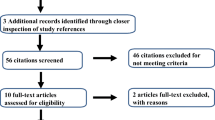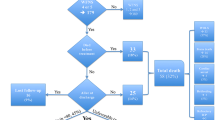Abstract
Background
Poor-grade aneurysmal subarachnoid hemorrhage (aSAH), defined as Hunt and Hess (HH) grades IV and V, is a challenging disease because of its high mortality and poor functional outcomes. The effectiveness of bundled treatments has been demonstrated in critical diseases. Therefore, poor-grade aSAH bundled treatments have been established. This study aims to evaluate whether bundled treatments can improve long-term outcomes and mortality in patients with poor-grade aSAH.
Methods
This is a comparative study using historical control from 2008 to 2022. Bundled treatments were introduced in 2017. We compared the rate of favorable outcomes (modified Rankin Scale score 0–2) at 6 months and mortality before and after the introduction of the bundled treatments. To eliminate confounding bias, the propensity score matching method was used.
Results
A total of 90 consecutive patients were evaluated. Forty-three patients received bundled treatments, and 47 patients received conventional care. The proportion of patients with HH grade V was higher in the bundle treatment group (41.9% vs. 27.7%). Conversely, the proportion of patients with fixed pupils on the initial examination was higher in the conventional group (30.2% vs. 38.3%). After 1:1 propensity score matching, 31 pairs were allocated to each group. The proportion of patients with 6-month favorable functional outcomes was significantly higher in the bundled treatments group (46.4% vs. 20.7%, p = 0.04). The 6-month mortality rate was 14.3% in the bundled treatments group and 27.3% in the conventional group (p = 0.01). Bundled treatments (odd ratio 14.6 [95% confidence interval 2.1–100.0], p < 0.01) and the presence of an initial pupil reflex (odd ratio 12.0 [95% confidence interval 1.4–104.6], p = 0.02) were significantly associated with a 6-month favorable functional outcome.
Conclusions
The bundled treatments improve 6-month functional outcome and mortality in patients with poor-grade aSAH.


Similar content being viewed by others
References
Steiner T, Juvela S, Unterberg A, Jung C, Forsting M, Rinkel G. European stroke organization guidelines for the management of intracranial aneurysms and subarachnoid haemorrhage. Cerebrovasc Dis. 2013;35(2):93–112.
Schuss P, Hadjiathanasiou A, Borger V, Wispel C, Vatter H, Guresir E. Poor-grade aneurysmal subarachnoid hemorrhage: factors influencing functional outcome: a single-center series. World Neurosurg. 2016;85:125–9.
Shen J, Yu J, Huang S, et al. Scoring model to predict functional outcome in poor-grade aneurysmal subarachnoid hemorrhage. Front Neurol. 2021;12: 601996.
Hoogmoed J, Coert BA, van den Berg R, et al. Early treatment decisions in poor-grade patients with subarachnoid hemorrhage. World Neurosurg. 2018;119:e568–73.
de Oliveira Manoel AL, Goffi A, Marotta TR, Schweizer TA, Abrahamson S, Macdonald RL. The critical care management of poor-grade subarachnoid haemorrhage. Crit Care. 2016;20:21.
de Oliveira Manoel AL, Mansur A, Silva GS, et al. Functional outcome after poor-grade subarachnoid hemorrhage: a single-center study and systematic literature review. Neurocrit Care. 2016;25(3):338–50.
Taylor CJ, Robertson F, Brealey D, et al. Outcome in poor grade subarachnoid hemorrhage patients treated with acute endovascular coiling of aneurysms and aggressive intensive care. Neurocrit Care. 2011;14(3):341–7.
Wilson DA, Nakaji P, Albuquerque FC, McDougall CG, Zabramski JM, Spetzler RF. Time course of recovery following poor-grade SAH: the incidence of delayed improvement and implications for SAH outcome study design. J Neurosurg. 2013;119(3):606–12.
Gouvea Bogossian E, Diaferia D, Minini A, et al. Time course of outcome in poor grade subarachnoid hemorrhage patients: a longitudinal retrospective study. BMC Neurol. 2021;21(1):196.
Cho WS, Kim JE, Park SQ, et al. Korean clinical practice guidelines for aneurysmal subarachnoid hemorrhage. J Korean Neurosurg Soc. 2018;61(2):127–66.
Han Y, Ye F, Long X, et al. Ultra-early treatment for poor-grade aneurysmal subarachnoid hemorrhage: a systematic review and meta-analysis. World Neurosurg. 2018;115:e160–71.
Phillips TJ, Dowling RJ, Yan B, Laidlaw JD, Mitchell PJ. Does treatment of ruptured intracranial aneurysms within 24 hours improve clinical outcome? Stroke. 2011;42(7):1936–45.
Bijlenga P, Czosnyka M, Budohoski KP, et al. “Optimal cerebral perfusion pressure” in poor grade patients after subarachnoid hemorrhage. Neurocrit Care. 2010;13(1):17–23.
Svedung Wettervik T, Howells T, Lewén A, Ronne-Engström E, Enblad P. Temporal dynamics of ICP, CPP, PRx, and CPPopt in high-grade aneurysmal subarachnoid hemorrhage and the relation to clinical outcome. Neurocrit Care. 2021;34(2):390–402.
Ransom ER, Mocco J, Komotar RJ, et al. External ventricular drainage response in poor grade aneurysmal subarachnoid hemorrhage: effect on preoperative grading and prognosis. Neurocrit Care. 2007;6(3):174–80.
Alotaibi NM, Elkarim GA, Samuel N, et al. Effects of decompressive craniectomy on functional outcomes and death in poor-grade aneurysmal subarachnoid hemorrhage: a systematic review and meta-analysis. J Neurosurg. 2017;127(6):1315–25.
Choi W, Kwon SC, Lee WJ, et al. Feasibility and safety of mild therapeutic hypothermia in poor-grade subarachnoid hemorrhage: prospective pilot study. J Korean Med Sci. 2017;32(8):1337–44.
Pasarikovski CR, Alotaibi NM, Al-Mufti F, Macdonald RL. Hypertonic saline for increased intracranial pressure after aneurysmal subarachnoid hemorrhage: a systematic review. World Neurosurg. 2017;105:1–6.
Panni P, Donofrio CA, Barzaghi LR, et al. Safety and feasibility of lumbar drainage in the management of poor grade aneurysmal subarachnoid hemorrhage. J Clin Neurosci. 2019;64:64–70.
Yu H, Guo L, He J, Kong J, Yang M. Role of decompressive craniectomy in the management of poor-grade aneurysmal subarachnoid hemorrhage: short- and long-term outcomes in a matched-pair study. Br J Neurosurg. 2021;35(6):785–91.
Won SY, Kim MK, Song J, Lim YC. Therapeutic hypothermia in patients with poor-grade aneurysmal subarachnoid hemorrhage. Clin Neurol Neurosurg. 2022;221: 107369.
Mocco J, Ransom ER, Komotar RJ, et al. Preoperative prediction of long-term outcome in poor-grade aneurysmal subarachnoid hemorrhage. Neurosurgery. 2006;59(3):529–38 (discussion 529-538).
van den Berg R, Foumani M, Schröder RD, et al. Predictors of outcome in World Federation of Neurologic Surgeons grade V aneurysmal subarachnoid hemorrhage patients. Crit Care Med. 2011;39(12):2722–7.
Brawanski N, Dubinski D, Bruder M, et al. Poor grade subarachnoid hemorrhage: treatment decisions and timing influence outcome. Should we, and when should we treat these patients? Brain Hemorrhages. 2021;2(1):29–33.
Zheng K, Zhong M, Zhao B, et al. Poor-grade aneurysmal subarachnoid hemorrhage: risk factors affecting clinical outcomes in intracranial aneurysm patients in a multi-center study. Front Neurol. 2019;10:123.
Schwartz C, Pfefferkorn T, Ebrahimi C, et al. Long-term neurological outcome and quality of life after world federation of neurosurgical societies grades IV and V aneurysmal subarachnoid hemorrhage in an interdisciplinary treatment concept. Neurosurgery. 2017;80(6):967–74.
Zhao B, Yang H, Zheng K, et al. Preoperative and postoperative predictors of long-term outcome after endovascular treatment of poor-grade aneurysmal subarachnoid hemorrhage. J Neurosurg. 2017;126(6):1764–71.
Ironside N, Buell TJ, Chen CJ, et al. High-grade aneurysmal subarachnoid hemorrhage: predictors of functional outcome. World Neurosurg. 2019;125:e723–8.
Liu J, Xiong Y, Zhong M, et al. Predicting long-term outcomes after poor-grade aneurysmal subarachnoid hemorrhage using decision tree modeling. Neurosurgery. 2020;87(3):523–9.
Wostrack M, Sandow N, Vajkoczy P, et al. Subarachnoid haemorrhage WFNS grade V: is maximal treatment worthwhile? Acta Neurochir (Wien). 2013;155(4):579–86.
Konczalla J, Seifert V, Beck J, et al. Outcome after Hunt and Hess Grade V subarachnoid hemorrhage: a comparison of pre-coiling era (1980–1995) versus post-ISAT era (2005–2014). J Neurosurg. 2018;128(1):100–10.
Venkatesh B, Schlapbach L, Mason D, et al. Impact of 1-hour and 3-hour sepsis time bundles on patient outcomes and antimicrobial use: a before and after cohort study. Lancet Reg Health West Pac. 2022;18: 100305.
Parry-Jones AR, Sammut-Powell C, Paroutoglou K, et al. An intracerebral hemorrhage care bundle is associated with lower case fatality. Ann Neurol. 2019;86(4):495–503.
Borgert MJ, Goossens A, Dongelmans DA. What are effective strategies for the implementation of care bundles on ICUs: a systematic review. Implement Sci. 2015;10:119.
Wartenberg KE. Critical care of poor-grade subarachnoid hemorrhage. Curr Opin Crit Care. 2011;17(2):85–93.
Samuels OWA, Culler S, Martin K, Barrow D. Impact of a dedicated neurocritical care team in treating patients with aneurysmal subarachnoid hemorrhage. Neurocrit Care. 2011;14(3):334–40.
Knopf L, Staff I, Gomes J, McCullough L. Impact of a neurointensivist on outcomes in critically ill stroke patients. Neurocrit Care. 2012;16(1):63–71.
Egawa S, Hifumi T, Kawakita K, et al. Impact of neurointensivist-managed intensive care unit implementation on patient outcomes after aneurysmal subarachnoid hemorrhage. J Crit Care. 2016;32:52–5.
Ryu JA, Yang JH, Chung CR, Suh GY, Hong SC. Impact of neurointensivist co-management on the clinical outcomes of patients admitted to a neurosurgical intensive care unit. J Korean Med Sci. 2017;32(6):1024–30.
Okazaki T, Kuroda Y. Aneurysmal subarachnoid hemorrhage: intensive care for improving neurological outcome. J Intensive Care. 2018;6:28.
Funding
This research did not receive any specific grant from funding agencies in the public, commercial, or not-for-profit sectors.
Author information
Authors and Affiliations
Contributions
Conceptualization: EJH. Formal analysis: YHC. Investigation: YS, JK, Y-HC, HSK, SHL, KmK, W-SC, H-SK, JEK. Writing (original draft): YHC. Writing (review and editing): EJH. All authors approved the final version of the manuscript before submission.
Corresponding author
Ethics declarations
Conflict of interest
The authors declare that they have no conflict of interest.
Ethical Approval/Informed Consent
All procedures performed in studies involving human participants were in accordance with the ethical standards of the institutional and/or national research committee and with the 1964 Helsinki Declaration and its later amendments or comparable ethical standards. The institutional review board of our institute approved this study (No. 2302-045-1402). Informed consent was waived for the retrospectively studied participants because our study did not adversely affect their rights and welfare. Participants or the legal guardians of participants in the newly developed bundle protocol group provided written informed consent prior to study enrollment.
Additional information
Publisher's Note
Springer Nature remains neutral with regard to jurisdictional claims in published maps and institutional affiliations.
The commentary to this article is available at https://link.springer.com/article/10.1007/s12028-023-01817-y.
Supplementary Information
Rights and permissions
Springer Nature or its licensor (e.g. a society or other partner) holds exclusive rights to this article under a publishing agreement with the author(s) or other rightsholder(s); author self-archiving of the accepted manuscript version of this article is solely governed by the terms of such publishing agreement and applicable law.
About this article
Cite this article
Choi, Y.H., Ha, E.J., Shim, Y. et al. Clinical Outcome of Patients with Poor-Grade Aneurysmal Subarachnoid Hemorrhage with Bundled Treatments: A Propensity Score-Matched Analysis. Neurocrit Care 40, 177–186 (2024). https://doi.org/10.1007/s12028-023-01818-x
Received:
Accepted:
Published:
Issue Date:
DOI: https://doi.org/10.1007/s12028-023-01818-x




